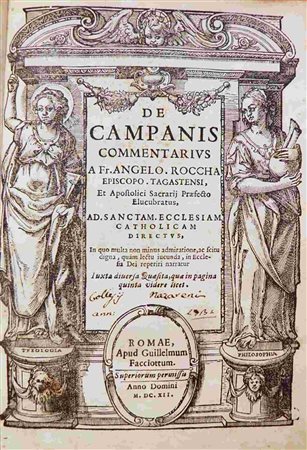 Bertolami Fine Art - Sendlinger Straße 24, 80331 Monaco
Bertolami Fine Art - Sendlinger Straße 24, 80331 Monaco
WEB AUCTION 118 - LIBRI E AUTOGRAFI WEB AUCTION 118 - LIBRI E AUTOGRAFI
Thursday 16 June 2022 hours 14:00 (UTC +01:00)
ANGELO ROCCHA (1545-1620): De Campanis commentarius a Fr. Angelo Roccha Episcopo Tagastensi, et apostolici sacrarij Praefecto elucubratus ... Romae, apud Guillelmum Facciottum, 1612
Angelo Roccha (1545-1620)
De Campanis commentarius a Fr. Angelo Roccha Episcopo Tagastensi, et apostolici sacrarij Praefecto elucubratus ... Romae, apud Guillelmum Facciottum, 1612
§ 4to (170 x 230.); viij, 168, [30, 1st and last leaf blank] pp. Signature: 1-4, A-Y1-4, Z1-6, a1-4 (X4 and a4 blanks). 4 (3 folding) plates; title within woodcut allegorical frame, woodcut initials. Ownership annotation on title page Collegij Nazareni ann: 1734. Contemporary vellum, handwritten title on spine. Ties missing. Z5-a4 traces of worm-holes in inner margin, skilfully restored; inner margin of the plates restored, not affecting the engravings; some foxing/browning in places; traces of worm-holes on endpapers. A good copy.
First edition. Angelo Rocca (1545-1620), scholar and philologist, is best remembered as the founder of the Biblioteca Angelica and bishop in partibus of Tagaste; was also a collaborator of the Manutius and director of the Vatican Printing House under Sixtus V and an active collaborator in drafting the text of the ‘vulgata’ bible, definitively edited in 1592. He also wrote some books concerning astronomy, mentioned by Riccardi. One of the first treatises exclusively devoted to bells (preceded only by Maggi’s De tintinnabulis, published in 1608), the present work describes the origin of bells, their terminology, the functions of the bell-ringer and the liturgical occasions in which the bells are played. The four beautiful plates depict the clock of San Marco in Venise, the clock in Liège and an illustration of chimes, reproduced later in the Frisius edition of Maggi's book as well as in Bonanni.




